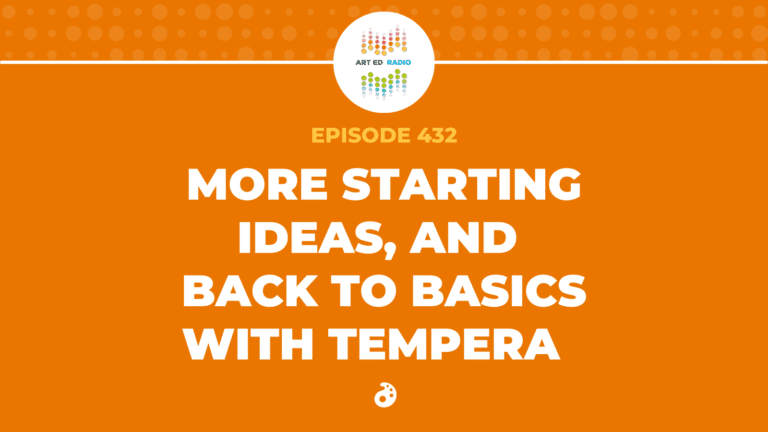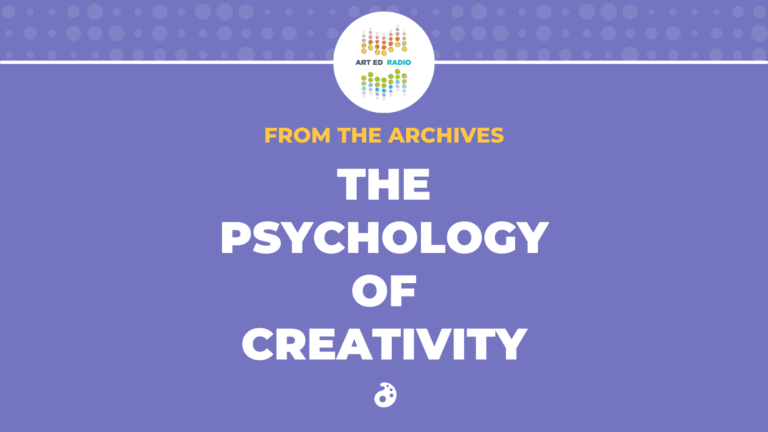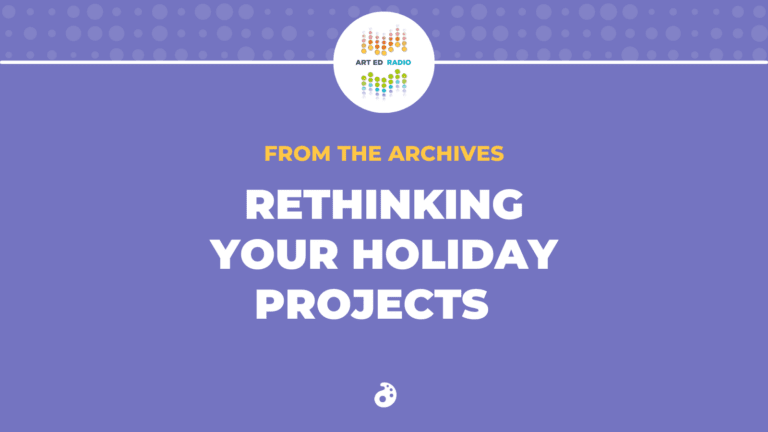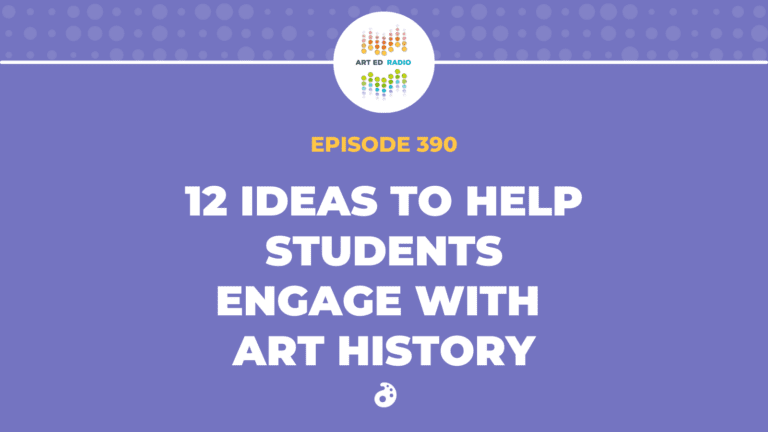Teaching kindergarteners is always a challenge. But what does it look like this year, when many kindergarteners are coming to you with no experience ever being in a classroom? Listen today as Nic and Lindsey Moss talk about helping fine motor skills and foundational art experiences, as well as Lindsey’s new 1-2-3, A-R-T! YouTube series. Full Episode Transcript Below.
Resources and Links
- Subscribe to AOEU’s Youtube Channel
- Teaching Kindergarteners About Primary Colors
- Learning to Love Kindergarten
- Check out the Rethinking Kindergarten graduate course
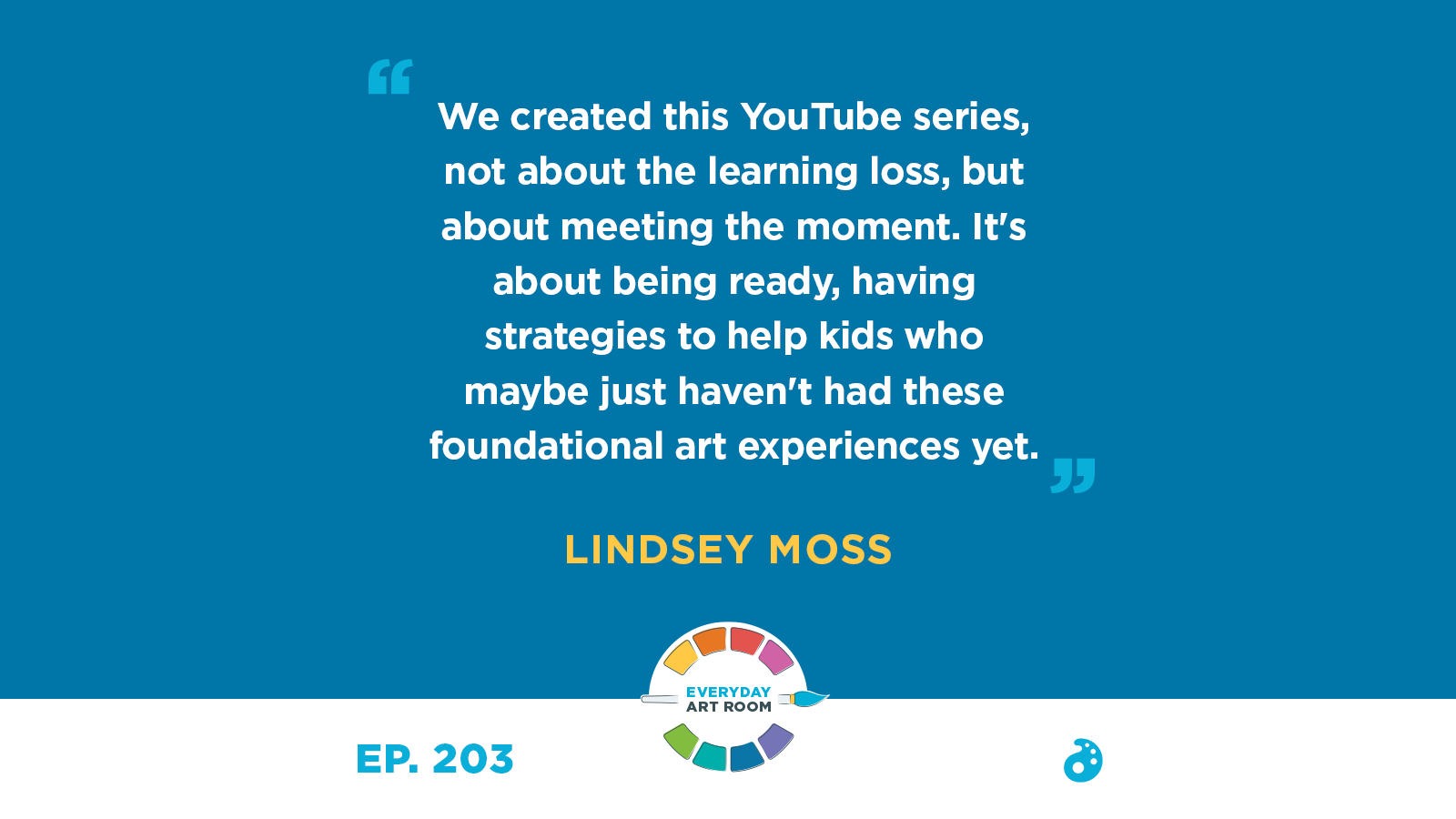
Transcript
Lindsey: Hi, Lindsey Moss here for The Art of Education University, coming to you from Yorkville, Illinois for this series of YouTube episodes, 1, 2, 3, A.R.T.
Nic: What? Lindsey Moss? YouTube? What’s going on? Don’t worry. This is actually Nic Hahn, and this is Everyday Art Room. But what we’re going to talk about today is The Art of Education University’s amazing new YouTube site. Okay, it’s not so new, but a lot of the things that we’re doing in the next couple of months will be completely new and something of great value to you. This is Nic Hahn, and this is Everyday Art Room.
I’m really, really excited to talk about this today. This is something that I’ve been sitting on since the summer. We got together as a professional development team for The Art of Education University. Of course, we have over 100, by a lot, over 100 employees of some of the most knowledgeable art educators and of course our team expands farther than that. We have video production, we have graphic design, we have a business department and a HR department. We have all the things and every employee that I work with through The Art of Education I absolutely respect and admire. We just have a wonderful team. And recently we have… Well, let’s reverse. In the past, we’ve gotten together as this large team of employees and actually came from all over the United States. That is super fun, super amazing to meet these educators and team that I work with on a regular basis, all come together and actually see each other in person because The Art of Education is remote for the most part. We are working from all over the nation.
Well, this year, due to the changes in our environment and restrictions and just keeping us safe, we decided to pare this down into smaller groups. We got together in Madison, Wisconsin, and our team looked like this. We had Amanda Heyn Tim Bogatz, those are names that you probably know, as well as Janet Taylor, Sarah Krajewski, Lindsey Moss, again, great art educators. You’ve definitely seen them with The Art of Education and throughout art education in general. And then new to our team is Chelsea Fleming and Lindsey McGinnis. I’m telling you this conversation with this team was exhilarating. I was so fueled. Fueled might be the word after talking to this group of people because these are people that are not only like-minded when it comes to art education, but more importantly, like-minded when it comes to positive outlooks on our state of education and our job of art educators.
What we were doing in this meeting was trying to get together all the different facets of The Art of Education and the offerings that we have for our participants and our community, and kind of make it more cohesive, make it blend together a little bit more and really understand what each other does a little bit better. So, we had representation from PRO, from FLEX. We had Instagram Live, we had our podcasts and we have the magazine. And now the brand new aspect that we’re really going to concentrate on in addition to everything else is YouTube. So, Lindsey McGinnis is our YouTube guru. She is our person who is going to make our YouTube amazing and she already has begun with this amazing series called 1, 2, 3 A.R.T. This is focused on early education and actually, I’m going to give this over to Lindsey Moss, who is the host of this series to kind of give an introduction to herself and the series to a certain extent.
Lindsey: So, I’ve been teaching kindergarten through sixth-grade art for almost two decades now. And I got to be transparent, kindergarten is still my biggest professional challenge. I love them. They come into the art room so excited and a lot of times the things you’re showing them, they’ve never seen before, so there’s this sense that art class is super magical, but you pair that with these really… Developmentally, they have really short attention spans, and a lot of them are still learning their fine motor and it’s just really a challenge, right? So, I’m looking at this fall with concern because we’re expecting a really large kindergarten class in Yorkville at my school where I’m going to have, oh gosh, somewhere between 80 and 90 kids. Don’t worry. That’s not in one section. It’ll all be broken up into different classes, but I’m looking at how a lot of these kids may not have had in-person preschool or in-person educational childcare.
And so, a lot of the skills that I think normally come from our amazing preschool educators, things like how to write your name, how to hold a pair of scissors, how to use glue, a first painting experience, a lot of these things, if they didn’t happen at home, they didn’t happen. And so, you’re looking at a group of kids coming in who number one, have really never done school. Things like raising their hand, being in a line, they really not had experiences with that. But then even more, all these fine motor things that we kind of expect some level of knowledge when they enter kindergarten might not be there. And I feel like the national conversation has really been about learning loss or the learning gap, but I just don’t love that. I don’t feel like it honors these kids, this whole generation of kids who’ve had to be really flexible and resilient and brave in the face of a lot of tragedy and in a pretty scary world for 18 months.
They are amazingly strong kids. So, learning loss isn’t really how I want to describe this. So, we were all chatting up in Madison this summer about what we could do to help art teachers and The Art of Ed already has a lot of great resources for kindergarten classroom management, kindergarten curriculum, instructional strategies. What we don’t have is what to do if your kindergarteners have pre-K level fine motor skills. So, we created this YouTube series, not about the learning loss, but about meeting the moment, being ready, having strategies to help kids who maybe just haven’t had these foundational art experiences yet. And it was so fun to film. I had four friends from Yorkville that are either going into kindergarten or going into first grade come and hang out in the art room for an afternoon. And we tried a whole bunch of these different techniques for how you can explain scissors or glue in an effective way that will really help kids get up to speed quickly.
So, yeah, there’s, I believe going to be seven episodes. The last one’s a Q&A. We took some questions off of Facebook and each episode is really just chock-full of tips and tricks. I did a ton of research this summer over preschool and actually occupational therapy blogs for all different kinds of tips, tricks, and techniques that people use and when I found one that is used universally by a lot of people, then I would try it out with kids I knew to make sure it was I’m going to be great for my classroom. And so, what we’ve put together, I think is like a pretty deep dive into what you can do to help your youngest artists get up to speed as quickly as possible this fall. So, I hope people are going to watch and enjoy it.
Nic: Lindsey has a lot to be proud of in this series. It’s exactly what we need right now, especially if you’re teaching young artists such as kindergarten, first grade or preschool. This is exactly what we need. First of all, she mentioned that mind shift, that mind shift from learning gap which is just so negative to making this completely different idea and saying, “We’re going to meet them in the moment. We’re going to find where they’re at and provide exactly what they need.” That is what the series does so clearly. And with so many great physical tips that you can put right into your classroom, it just makes me really proud to be there in the birth of this idea. It was really fun to have this conversation with this group and listen to it develop, develop from, “We have kindergarten and they’ve never done this and this is going to be so hard.” By the end of our weekend, we had changed our whole tone, our whole mindset and then, this is what the result was.
“We’re going to meet them in the moment and we’re going to do it in a way that we can help our teachers meet every student in the moment that they’re in.” So, let’s just kind of break down the series that we’re going to be seen on YouTube. It’s going to be good. So, it actually gets started with just the simplest thing. You’re going to see a trailer first. And then in the playlist, the series, the first thing that we’re going to talk about is writing our names. Kindergarteners have a very difficult time, or some kindergarteners have a difficult time writing their names. There is going to be three tips that Lindsey is going to give that makes her beginning of the year a little bit more smooth, meeting her students in the moment that they come into her. Some students have more of a background. We know this, they have gone to preschool and this is true of every year, not just the COVID year, they’ve gone to preschool and then their neighbor, the person sitting directly next to them has never held a pencil. And this is no exaggeration.
Some students had been writing their name for years and some have never attempted the characters of letters. So, three easy tips, things that you can implement immediately, will be in the first episode of this series. The next one, the episode two, we’re going to see how to reinforce that pincher grip, how to hold the pencil correctly? Also, what kind of adaptations can we give to our students to make sure that they’re most successful and why? Why should we care as art educators how a student holds their pencil? If the job gets done, who cares how they get it done? Well, there’s reasons for all of it.
And Lindsey is actually going to bring us through eight different ways to reinforce that pencil grip. That’s awesome. Eight ways. Well, it does make sense. She is one that has been teaching for multiple years. And as we were talking around the table, she was standing there saying, “I have thought about this. I have researched, I have looked, I have examined what needs to be done, what I need to do in my classroom. And if I can clearly make that part of my language and part of my vision for the beginning of the school year, why not share it with the rest of art education.” And so, I’m very grateful that she put this all together because I’ll tell you if she did a lot of legwork for us. In episode three, she’s going to do some fun tricks of how to get students, how to use scissors the best, especially early scissor people.
And what I like about this is throughout all of these, you’re going to see these four adorable students that are actually putting into practice some of the tricks that she’s telling us about. So, it’s really fun to see those little hands attempting it. And she nails it on the head when she says, “Some students are going to have a hard time with this.” And sure enough, that is what happens right there on the video in life, without prompting from the students that she’s working with.
We moved down to episode four where she’s going to talk about glue and yes, yes, yes. We know… not a lot, but I think we need to go further. So, Lindsey is going to bring us through the different tools that you can use for gluing the different techniques that you can use for gluing and just really give some good options for people who are just getting started using glues. I really like the tips that she gives for painting as well.
So she talks about the water dishes, but also a technique that I use in my classroom as well. I bet some of you do as well of just using water as the paint. So again, you’re going to have to kind of watch the YouTube series to really get an understanding of what that means, but it is a super solution. Just one that you can easily bring into your kindergarten classroom, fill up your time, maybe a half-hour, an hour of just painting with the paper, learning the brush and also just water. So there’s no paint involved, we’re getting rid of a whole step so that you can easily scaffold to where the students are and meeting them in the moment.
Episode six is going to be just a concentration on all the supplies that were mentioned throughout the rest of the series. So, it’s going to be really a look at the different tools because as she mentions them, I know that there’s going to be product links for everything that she mentions underneath each of the videos. But what’s really nice is hearing the breakdown of like, “Okay. Wait, why do I want this crayon? Why are the crayons I’m using currently maybe not the best for meeting our students at the moment that they’re in?” And then also, “Where do I get those supplies?” What I also like about Lindsey is she is smart enough to know that we don’t have this endless budget to buy all these adapted things. So, she gives hints of talking to your OT, finding out if there’s different monetary areas where you can maybe find some extra funds. If it is adapted needs, well, there might be some funds out there for you to use.
And then also she just mentions like, “Okay. These are the must-haves. These are the wants. These are the… If I have some extra money in my budget type of a deal.” So, she brings us through that. At the end, there is a question and answer time with Lindsey. So, these questions were put out to Facebook people, and it’s just like, “What are you wondering about kindergarten right now?” And a bunch of people did reply because we have an amazing community that is active in conversation. And so, they chose a few, I think it was like, I don’t know, six, seven different questions that Lindsey just uses her knowledge of experience to share what works best for her. This series is such a gift. It’s such a gift to me, it’s such a gift to you. And it is just a real nice flavor of what’s to come.
Lindsey McGinnis is the person behind all of this. She’s developing the vision for YouTube. She’s really thinking about how are we going to lay this out? How are we going to give free content that is powerful for our teachers? And what is the feeling that we’re going to give them with this discussion? This teaming of the Lindseys was a powerful start to the beginning of our YouTube series. I’ve already had the opportunity to take a look at all of these videos after their production. And they are spectacular. They’re really, really good. And they gave me even being in the room and having these conversations, watching the videos, allowed me to truly understand what Lindsey’s vision was. And I’m totally hacking about 90% of what she had to say because I loved so many of the ideas and conversations that she had with these young artists who were in her video with her.
One of the biggest ones I’m just going to… This is a spoiler alert. If you want to just watch this firsthand, go ahead and skip to the end of this podcast. But one of the big tips that I am going to implement is they did a yes, no. What can you cut? And what can’t you cut? Not just how do you cut with your scissors, like how do you hold it in your hands? But what can, and what can’t you cut? I should have implemented this a few years ago because there was certainly quite a few haircuts that has happened under my watch. And it’s unfortunate when I have to call a parent and say, “Remember that hair your daughter came to school with? Yeah, a section of that’s gone. Sorry about that.” So, she suggests going through a yes and no kind of process. What can you cut? Can you cut paper? Yes, let’s put that under the yes. Can you cut… One of the kiddos says a brick. You can’t cut a brick. You’re right. Yes. We should not cut bricks. Oh, kindergarten. I love it.
So, we went through all of that, including hair that was mentioned in the video. And that really does set the ground rules for like, “Yeah, this is how we handle scissors. This is what we can cut with them. And so we have good protocols set up.” Great idea, Lindsey. I love that one, one I will be using for sure. But overall, this series repeats over and over and over. And whether you are teaching kindergarten or not, if you are teaching freshmen in high school, if you are teaching any student this year, listen to this word, meet them at the moment. This is not a learning loss. Just because they are not in the same place that other students have been in the past does not mean that they have lost anything, it just means that they haven’t gained it yet. It does not mean they’re behind. It means we need to meet them where they’re at. They’ll catch up.
They’ll probably excel. But what we have to do is make sure that we are not talking above them. We are bringing it right to their level, right where they’re at and they will catch on so fast because guess what, a lot of these students have had an additional year of life. They’re more mature. Their fine motor skills can handle this probably quicker than our students in previous years. But we just have to make sure that we’re covering all of our basis, meeting them where they’re at, meeting them at their moment. Keep that in mind as you run forward in this school year as you’re moving into the school year and then make sure to check out our new YouTube resources.
Let’s wrap up today by listening to Lindsey one more time as she finishes up introducing her series 1, 2, 3 A.R.T.
Lindsey: The Art of Education has you covered. In this YouTube series, we are going to focus on all the skills that your students might not have yet. And we’ll help you meet the moment this fall. They just need a couple of strategies to help them with their fine motor as they get up to speed in August and September. We have a lot to cover in the future episodes. Make sure that you like and subscribe to our channel so that you don’t miss a single episode of 1, 2, 3 A.R.T as well as all the other fabulous content coming from The Art of Education University.
Nic: Couldn’t have said it better myself, however, I do want to emphasize the fact that subscribing and liking is really important on any YouTube or any social media. The reason being it tells us all the information we need to know. This is something I care about, something I’m using, something I like, something I want more of. Give us that feedback and be sure to subscribe so that you can see the exciting new series that we will be implementing on a regular basis.
Magazine articles and podcasts are opinions of professional education contributors and do not necessarily represent the position of the Art of Education University (AOEU) or its academic offerings. Contributors use terms in the way they are most often talked about in the scope of their educational experiences.
